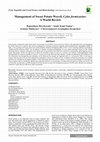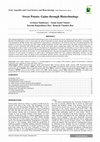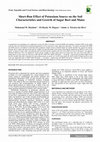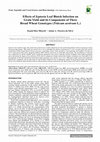Papers by Global Science Books

Fruit, Vegetable and Cereal Science and Biotechnology, 2012
Sweet potato [Ipomoea batatas L. (Lam.)] is a staple food in many of the developing countries of ... more Sweet potato [Ipomoea batatas L. (Lam.)] is a staple food in many of the developing countries of tropics and sub-tropics also serves as animal feed and raw material for the industries. Sweet potato area globally has been showing a declining trend. This decline was more predominantly seen in Asia followed by Latin America. Sweet potato yields globally showed an increasing trend in all periods, except during 2001-2010 where it recorded a significant decline at 1.0%/annum. This to some extent and significant production growth in Africa compensated for the effect of global decline in sweet potato area on production. Asia continued to have its dominance in spite of the fact that area, production and yield of the crop has showed a declining trend during the past decade. All the major sweet potato-growing African countries recorded significant growth in sweet potato area and production during 1961-2010. Serious and concentrated efforts are needed to exploit its potential in producing many value added products and promoting the orange fleshed sweet potato especially in the African continent to reverse the current declining trends.
Fruit, Vegetable and Cereal Science and Biotechnology, 2012
Sweet potato is infested by root-knot and reinform nematodes. Root-knot nematode infestation in s... more Sweet potato is infested by root-knot and reinform nematodes. Root-knot nematode infestation in sweet potato is studied in detail. A number of resistant varieties are released in sweet potato from USA, Japan and China. A number of germplasm accessions and cultivars/ varieties were found resistant to the nematodes in Peru. Studies carried out by the authors indicated that sweet potato germplasm is resistant to root-knot nematode in general and susceptibility is less. 'Sree Bhadra', a high yielding variety of sweet potato is found as a resistant trap crop of root-knot nematode. Pratylenchus and Ditylenchus are also known to cause serious damage in Japan and China, respectively. However, they are not serious in India and it is desirable to be quarantined in India.
Fruit, Vegetable and Cereal Science and Biotechnology, 2012
Postharvest rots of sweet potato are mostly caused by fungi. The most important rot causing fungi... more Postharvest rots of sweet potato are mostly caused by fungi. The most important rot causing fungi are Botryodiplodia theobromae (Java black rot), Rhizopus oryzae (soft rot or Rhizopus rot), Fusarium spp. (Fusarium rot), Ceratocystis fimbriata (black rot), Sclerotium rolfsii (Sclerotium rot), Macrophomina phaseolina (charcoal rot), Cochliobolus lunatus (Curvularia lunata), Rhizoctonia solani and Plenodomus destruens, in that order. Curing to promote wound healing, fungicide treatment, bio-control, UV-irradiation, and improved storage practices were found to have intermediate impact in controlling these rots. The other viable proposition is to cultivate rot-resistant/tolerant varieties.

Fruit, Vegetable and Cereal Science and Biotechnology, 2012
Among the tropical tuber crops, sweet potato comes next to cassava in starch content. The article... more Among the tropical tuber crops, sweet potato comes next to cassava in starch content. The article reviews the extraction of starch from sweet potato tubers, and the physicochemical, functional, thermal and rheological characteristics of sweet potato flour and starch. Wide variation in biochemical constituents is observed depending on the origin of the tubers and processing conditions. The lipid and phosphorus contents are low. The starch granules are round, 3-45 μm in size and have distinct XRD patterns. The amylose content, swelling, solubility and digestibility characteristics depend on a number of factors like age of crop, method of extraction and varietal differences. The viscosity and rheology properties are also quite diverse among the varieties. DSC analysis indicates pasting temperature to be between 60 and 88°C while enthalpy of gelatinization is 10-18 J/g. Heat moisture treatment alters some of the properties.

Fruit, Vegetable and Cereal Science and Biotechnology, 2012
Alternative sources of livestock feed to spur livestock production and to free cereal supplies fo... more Alternative sources of livestock feed to spur livestock production and to free cereal supplies for human consumption are receiving closer attention. Sweet potato has higher biological efficiency as food and shows highest productivity (35-45 t ha-1). It has relatively short vegetative cycle (4-5 months). Hence, fits nicely into tight cropping systems. It also competes better with weeds than other root and tuber crops. The DM content of sweet potato varieties ranges from 21.70 to 34.78% which is more than cassava. Its tubers can be given to all ruminants as fresh, chopped tubers, dried chips and silage for energy supplements along with locally available grasses during the dry season. Sweet potato vine and foliage is a common feed for pigs, and other livestock, in many countries, including China, India, and a few eastern islands of Indonesia (Bali and Irian Jaya), Korea, Philippines, Papua New Guinea, Taiwan, Uganda and Vietnam. Sweet potato vines, commonly left unused, can also be used as a protein feed for animals. The skin and leaf tips contain comparatively higher protein, 50-90% and 18-21%, respectively. Tubers also contain essential amino acids, with the exception of the sulfur-containing amino acids, especially cystine/cysteine. Digestibility of tubers appears to be a problem in some countries for some varieties that are grown under certain types of conditions. Selections of varieties with low trypsin inhibitor activities help expand the plant's potential for wider use as an animal feed in developing countries. The main constraints to using sweet potato vines as pig feed are labor and storage. Sweet potato roots are the good source energy (3500 kcal kg-1) for poultry. The digestibility of sweet potato carbohydrate fraction is reported to be above 90%. From dual purpose lines, DM yield of 4.3-6.0 t ha-1 from foliage could be obtained. The main reasons for adoption of dual-purpose sweet potato are economical viability owing to relatively high yields, net returns and crude protein (CP) content of the fodder.

Fruit, Vegetable and Cereal Science and Biotechnology, 2012
Sweet potato (Ipomoea batatas (L.) Lam) is an important food crop belonging to the morning glory ... more Sweet potato (Ipomoea batatas (L.) Lam) is an important food crop belonging to the morning glory family (Convolvulaceae). It is cultivated throughout the tropics and warm temperate regions of the world for its edible storage roots. The crop has recently received more attention due to very high levels of pro-vitamin A in orange-fleshed sweet potatoes. Moreover, storage roots provide medium levels of iron and zinc. The nutritional profile of sweet potato leaves and tops reveal the presence of moisture content, crude protein, fibre and ash along with vitamin A and calcium. Since the storage roots of sweet potato possess a high nutritional profile, breeding strategies need to be developed to bring out new varieties which are scientifically feasible, farmer acceptable, with high nutritional status and cost effectiveness. In addition to its importance as human food, it provides raw material for animal feed and industrial purposes. Although, sweet potato is an important food crop, the improvement of the crop has been given very little attention. The genetics of sweet potato is little understood and the inheritance pattern is quite complex one. Genetic information on many traits of direct economic importance in sweet potato is not available and most published information is from the clones of similar genetic back ground. Studies on the entire spectrum of the variability are therefore necessary to acquire knowledge on the inheritance pattern. This chapter briefly reviews the nutritional qualities and breeding patterns of sweet potato with special focus on the chemical components of the sweet potato leaves and storage roots.

Fruit, Vegetable and Cereal Science and Biotechnology, 2012
Sweet potato is infested by many insect pests. Sweet potato weevil (SPW) Cylas formicarius (Fab.)... more Sweet potato is infested by many insect pests. Sweet potato weevil (SPW) Cylas formicarius (Fab.) is the important insect pest throughout the world, wherever it is grown. The weevil is managed by a package of practices together called integrated pest management (IPM). In India, a few genotypes of sweet potato have shown durable resistance throughout 2006 to 2011. A new screening method of germplasm, volatile-assisted selection (VAS), was developed to identify resistance/susceptibility in sweet potato genotypes based on the volatile chemicals that are released. Transgenic sweet potato was not successful at the field level. Farmers in Asia practice intercropping of sweet potato with ginger, bhendi, taro and yams to reduce the incidence of pests as well as to conserve soil moisture. Entomopathogenic fungi and nematodes are used successfully to control C. formicarius in the West and Latin America. Female sex pheromone (Z)-3-dodecen-1-ol (E)-2-butenoate has changed the pest dynamics in the field and has become an important tool in C. formicarius IPM. It was used to monitor and trap male weevils, thus reducing the reproductive success of female weevils. A number of botanical pesticides are available and their use is limited in developed countries. A few insecticides that were used to control C. formicarius were banned in recent years in many countries and it is essential to identify new molecules with low or no persistence in tubers and soil with toxic effects on weevils. We reviewed the research done on SPW during the last five decades to assess the management practices of SPW and to identify new strategies required to control the pest effectively and economically.

Fruit, Vegetable and Cereal Science and Biotechnology, 2012
Yield of sweet potato cultivars have appeared to gradually decline over the years in most of the ... more Yield of sweet potato cultivars have appeared to gradually decline over the years in most of the sweet potato growing areas. This decline in yield and quality may be caused by a combination of several factors, including mutation, viruses and other pathogens. Several pathogens are known to cause diseases in sweet potato. Among them, the diseases caused by viruses are of worldwide economic importance. However, fungi, bacteria, viruses, nematodes and phytoplasma are known to attack sweet potato. Pathogenic bacteria, although not very common, are responsible for important economic losses. They affect vascular tissue as well as storage and fibrous roots, thus causing vine wilting and rots. Fungal pathogens are classified according to the type of disease they cause, such as foliar, stem, storage root and post harvest diseases. Even though the specific management practices have not been developed for various sweet potato diseases since the crop is propagated through vine cuttings, most of the viral and fungal diseases could be avoided by selecting healthy planting materials and sanitation. In the present chapter, an attempt has been made to review the worldwide diseases of sweet potato and the available management practices. This would be highly useful to take precaution to avoid spread and loss and for identifying the occurrence of new diseases.

Fruit, Vegetable and Cereal Science and Biotechnology, 2012
The sweet potato [Ipomoea batatas (L.) Lam] is a native species of South America belongs to the g... more The sweet potato [Ipomoea batatas (L.) Lam] is a native species of South America belongs to the genus in the family Convolvulaceae. Sweet potato is the seventh most important crop in the world and a major source of food and nutrition in developing countries. World sweet potato production is around 106 million tons in an area of about 8.1 million ha. Asia is the world's largest sweet potato producing region with the maximum production of 88.5 million tons in 4.4 million ha. China is the world's leading sweet potato producer with 81 million tons and contributes 76% to the world's production followed by Uganda with 2 million tons. So far three genetic linkage maps developed in sweet potato using different mapping population. Molecular markers were used to map the genes of root knot nematode resistance, carbohydrate metabolic genes, feathery mottle virus resistance, virus disease and carotene genes were studied using different markers. Similarly, genetics diversity work done in sweet potato worldwide with different source of germplasm and different marker system like morphological, RAPD, ISSR, SSR, DAF, AFLP, SAMPL for identifying duplicates and developing core collection in the germplasm.

Fruit, Vegetable and Cereal Science and Biotechnology, 2012
Sweet potato belongs to Ipomoea series batatas and is thought to have originated in Central Ameri... more Sweet potato belongs to Ipomoea series batatas and is thought to have originated in Central America and Northern South America. World sweet potato production is around 106 million tons in an area of about 8.1 million ha. Asia is the world's largest sweet potato-producing region and China is the world's leading sweet potato-producing country accounting for about 76% of production. Sweet potato has not attracted the attention from modern geneticists that many other economically important crops have because of its high ploidy. The genes related to tuber storage protein, sporamin, sucrose metabolic genes, storage root-inducing genes, proteinase inhibitors, cystein proteniase, retrotranspogens, and senescence-related genes were studied in sweet potato; similarly, sporamin, wound regulated, peroxidase and GBSS promoters were used for developing transgenic plants. Transgenic plants sweet potato with biotic stress (weevil, virus), abiotic stress (drought, early frost, low temperature), and herbicide resistance as well as improved starch quality and fatty acid composition have been developed.

Fruit, Vegetable and Cereal Science and Biotechnology, 2012
Gains through application of modern plant biotechnological tools in any horticultural crop are en... more Gains through application of modern plant biotechnological tools in any horticultural crop are enormous and sweet potato is no exception. Recently biotechnological work in sweet potato has gained momentum in many national and international laboratories. Techniques like micropropagation through axillary shoot proliferation, organogenesis, embryogenesis and artificial seeds have led rapid propagation and reduction of diseases. Cryostorage and DNA finger printing techniques provide safer conservation and rapid characterization of vast genetic resources efficiently with minimum inputs. On the other hand, genetic engineering coupled with tissue culture technology is redesigning the crops to make it more productive. Development of transgenic sweet potato for resistance to weevil, feathery mottle virus and fungal diseases have been reported in international and national laboratories. Genetic engineering for higher protein content are also found to be quite successful in sweet potato. In vitro methodologies have also been developed for faster screening and evaluation of large collections of sweet potato for tolerance to salinity stress. Paclobutrazol (PBZ) and CaCl 2 mediated submergence tolerance was also reported in sweet potato. Days are ahead to have nutritionally enriched, disease, pest and salt tolerant sweet potato as source of food, nutrition security and economic sustainability in sweet potato growing countries around the world.
Fruit, Vegetable and Cereal Science and Biotechnology, 2012
Sweetpotato is an important tropical tuber crop cultivated mostly under temperate and mild tropic... more Sweetpotato is an important tropical tuber crop cultivated mostly under temperate and mild tropical climatic conditions. Its tubers are rich in carbohydrate and some are rich in carotene. The crop is vegetatively propagated through vines. The shoot emerging from the planted vine which grows rapidly for two months and later the growth rate slows down. Within three weeks after planting vines, tubers are formed which later develops into tuber. Soil nutrients such as nitrogen and potassium influence growth and yield of sweetpotato. Water deficit stress and high temperature are major abiotic stresses that affect sweetpotato growth and yield. Sweetpotato can tolerate low level of shade. This chapter presents recent research work done on physiological aspects that influence the growth and productivity of sweetpotato.

Fruit, Vegetable and Cereal Science and Biotechnology, 2012
Sweet potato (Ipomoea batatas L.), a versatile crop used as food, feed and raw material for indus... more Sweet potato (Ipomoea batatas L.), a versatile crop used as food, feed and raw material for industries has got the ability to adjust in any cropping systems. It is mainly cultivated in cereal based cropping systems. In China, sweet potato is primarily planted after wheat (Triticum aestivum L.) harvest in June and harvested before wheat sowing in October. It is cultivated in the intensive irrigated rice (Oryza sativa L.) and sugar cane (Saccharum officinarum L.) based cropping systems in Taiwan. In India, sweet potato is rotated with rice and fallow in upland ecosystem to regain soil fertility and suppress weeds and weevil. In many African countries, sweet potato is intercropped with cassava (Manihot esculenta Crantz), maize (Zea mays L.), sorghum (Sorghum bicolor L.) and a variety of other crops. It is also grown on the borders of the fields in association with maize, cassava, beans (Phaseolus spp.), banana (Musa spp.) and sorghum. It is grown throughout the year in home gardens under mixed cropping in Philippines. Sweet potato being insurance crop against natural calamities is grown as intercrop in plantation crops. However, further research is needed on agronomic aspects when sweet potato is considered in cropping systems for efficient utilization of natural resources, biotic and abiotic stress management and sustainable production.

Fruit, Vegetable and Cereal Science and Biotechnology, 2012
Sweet potato, a bio-efficient crop grown for edible roots has spread into Africa, Asia, Europe an... more Sweet potato, a bio-efficient crop grown for edible roots has spread into Africa, Asia, Europe and East Indies through batatas line and to the Philippines from Central and South America. Sweet potato is a staple food crop in many of the developing countries and serves as animal feed and raw material for many industrial products. It requires a moderately warm climate (21-26°C) with soil pH of 5.5-6.5. Heavy rainfall, high temperature and excess cloudiness encourage vegetative growth. In sweet potato, close spacing is generally recommended to achieve maximum root yield. Though sweet potato covers the soil quickly, weeding is necessary, particularly, in the early stages of the crop growth. Sweet potato requires, on an average, 2 mm of water per day in the early parts of the growing season which gradually increase to 5-6 mm per day prior to harvest. Cylas formicarius Fab. (sweet potato weevil) larvae and adult feeds on the roots and cause extensive damage both in field and in storage. It can be effectively managed by following an integrated pest management strategy. Sweet potato is harvested between 90 and 150 days after planting depending on the location and season. On an average, it yields storage root of 20-25 tonnes ha-1 with improved crop management practices.

Fruit, Vegetable and Cereal Science and Biotechnology, 2011
A V-shape system represents an efficient and popular option to increase yield and fruit quality. ... more A V-shape system represents an efficient and popular option to increase yield and fruit quality. Therefore, this study attempts to compare some physicochemical fruit characteristics of five apple cultivars grown in the Karaj area of Iran. The concerned apple cultivars were 'Golab-Kohanz', 'Fuji', 'Gala', 'Starking' and 'Delbar estival' that were grafted onto M.9 rootstock trained in a V system. All of these trees were planted in winter 2005. 'Golab-Kohanz' (Iranian cultivar) had the highest pH (4.85). Also 'Delbar estival' had the highest fruit weight (131.30 g), fruit length (5.91 cm), fruit diameter (6.72 cm) and L/D (0.87). In addition, 'Fuji' had the highest dry matter (21.71%) and incidence of fruit sunburn (56.92%). 'Golab-Kohanz' had the most ash (0.66) and TSS (16.12) levels. In addition, 'Starking' had the greatest fruit firmness (13.60 kg cm-2) and titrable acid (0.73).

Fruit, Vegetable and Cereal Science and Biotechnology, 2011
A greenhouse pot experiment was conducted to assess the effect of muriate of potash (MOP) and sul... more A greenhouse pot experiment was conducted to assess the effect of muriate of potash (MOP) and sulphate of potash (SOP) on the sandy and clay loam soil characteristics and growth parameters of two successive crops, sugar beet and maize. The anions associated with MOP and SOP caused a net addition of salts that likely produced a slight osmotic potential which was neither harmful nor caused any salinity hazards. Root volume and shoot fresh and dry weights of sugar beet plants were greater following the application of MOP at a rate of 196 kg.ha-1 in both soil types while root diameter and root fresh and dry weights were best when SOP at a rate of 240 kg.ha-1 was applied, although differences were not significant. Fresh and dry weights of maize plants grown on sandy soils were also lower than those of plants grown on clay loam soil. However, SOP and 50% SOP+50% MOP (120 kg.ha-1 + 88 kg.ha1-, respectively) produced higher fresh and dry weights than other treatments for maize plants grown on sandy soil. On the other hand, the fresh weight of plants grown on clay loam soil responded better to MOP+SOP (88 kg.ha-1 + 120 kg.ha1-, respectively) and MOP (196 kg.ha-1) treatments. The results clearly show that both sugar beet and maize plants respond differently depending on soil type and potassium source.
Fruit, Vegetable and Cereal Science and Biotechnology, 2011
In vitro microtuberization of potato (Solanum tuberosum L.) cvs. ‘Marfona’ and ‘Agria’ was studie... more In vitro microtuberization of potato (Solanum tuberosum L.) cvs. ‘Marfona’ and ‘Agria’ was studied by the use of individual excised single-node cuttings cultured on semi-solid MS medium supplemented with 5 mg L-1 BAP and 80 g/L sucrose in the presence of 0, 25, 50, 75, 100 and 150 mM NaCl or 30, 40, 60, 80, 100 and 120 g/L sucrose. Microtuberization decreased significantly with increasing salinity; the highest NaCl level (150 mM) completely inhibited microtuber development in both cultivars. Microtuber production was significantly increased by increasing sucrose concentration up to 80 g/L then reduced at higher concentrations.

Fruit, Vegetable and Cereal Science and Biotechnology, 2011
An investigation was carried out to study the effect of plant growth regulators (PGRs) on fruit q... more An investigation was carried out to study the effect of plant growth regulators (PGRs) on fruit quality and leaf mineral composition of litchi (Litchi chinensis Sonn.) cv. 'Bombai'. The treatments consisted of four sprays (applied between September and December at monthly intervals) of three PGRs: Į-naphthaleneacetic acid (NAA), gibberellic acid (GA 3) and kinetin. Treatment with any PGR significantly increased fruit weight, size, the edible: non-edible ratio, the biochemical constitutents of fruit and also the leaf mineral content (N, P and K). Treatment with NAA at 50 mg/L resulted in maximum fruit weight (24.22 g), size (3.8/3.4 cm) and edible ratio (2.25) followed by NAA at 25 mg/L while GA 3 at 100 mg/L recorded maximum TSS (19.8 °Brix), total sugar (14.30%), sugar: acid ratio (23.8) and ascorbic acid (32.25 mg/100 g pulp) content of fruit followed by GA 3 at 50 mg/L. Anthocyanin content of fruit peel was maximum with 50 mg/L NAA, although kinetin had little effect. Leaf mineral (N, P and K) contents were influenced by PGR treatments. Both NAA at 50 mg/L and GA 3 at 100 mg/L are equally effective in improving the fruit quality and leaf mineral composition of litchi.

Fruit, Vegetable and Cereal Science and Biotechnology, 2011
High temperature stress is a major environmental stress that adversely affects wheat growth and p... more High temperature stress is a major environmental stress that adversely affects wheat growth and productivity worldwide. The effect of high temperature stress on different physiological characters and yield attributes of five wheat genotypes differing in their susceptibility to high temperature stress was studied for two constitutive years. Seeds were planted under normal, late and very late dates in order to expose plants to different levels of temperature stress. Chlorophyll content, membrane stability index, rate of photosynthesis, leaf water spin lattice relaxation time, and transverse relaxation time were determined at the vegetative stage, anthesis and 15 days after anthesis. Water potential was determined at the anthesis stage, 7 and 15 days after anthesis. Pooled data of both years showed a significant reduction in all physiological characters under late and very late planting compared to normal planting date at all growth stages. However, heat-susceptible genotype PBW 343, which performed well when planted normally, showed a maximum reduction in all characters at all growth stages compared to heat-tolerant genotypes HDR-77 and HD 2815, which performed better under late and very late planting conditions. Plant biomass, grain yield/plant, 1000-grain weight, grain number/ear and grain weight/ear were significantly reduced under late and very late planting compared to normal planting. The yield attributes of PBW 343 and PBW 175 were most reduced under very late planting. HD 2815 and HDR-77 performed well and maintained higher yield when planted very late compared to other genotypes and a significant association between all physiological characters and yield components was observed. HD 2815 and HDR-77 showed minimum reduction in yield and yield components under late planting conditions while exhibiting stability and minimum reduction in all physiological characters.

Fruit, Vegetable and Cereal Science and Biotechnology, 2011
Septoria tritici (perfect stage, Mycosphaerella graminicola) is widely spread all over the world ... more Septoria tritici (perfect stage, Mycosphaerella graminicola) is widely spread all over the world and generates serious crop losses in many wheat-growing regions. This study was carried out in situ to determine the effects of infection by S. tritici on grain yield (GY) and its components of three bread wheat (Triticum aestivum L.) genotypes (Tanit, Tirant and Sérir 2). Two treatments were applied. The first one was a control plot treated with a fungicide (Dithane M45) and the second was an artificially infected plot. The development of infection was evaluated by IL and IP, AUDPC and R. Agronomic parameters were used to study the reaction variability of the studied genotypes and to determine the impact of the infection on GY and its components. Results showed that climatic conditions were favourable to the development of infection and that the tested bread wheat genotypes were sensitive to S. tritici. 1000-grain weight was the most negatively affected GY component. On the other hand, IL and IP partly explain the loss in 1000-grain weight. On the protected plots, the positive action of the fungicide enhanced plant tolerance and generated a synergy expressed by the improvement of GY and its components.

Uploads
Papers by Global Science Books